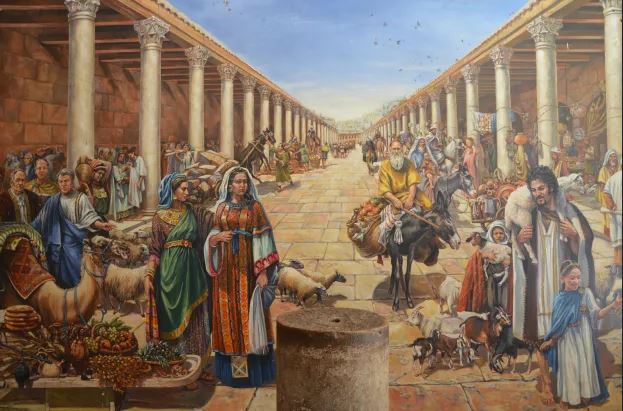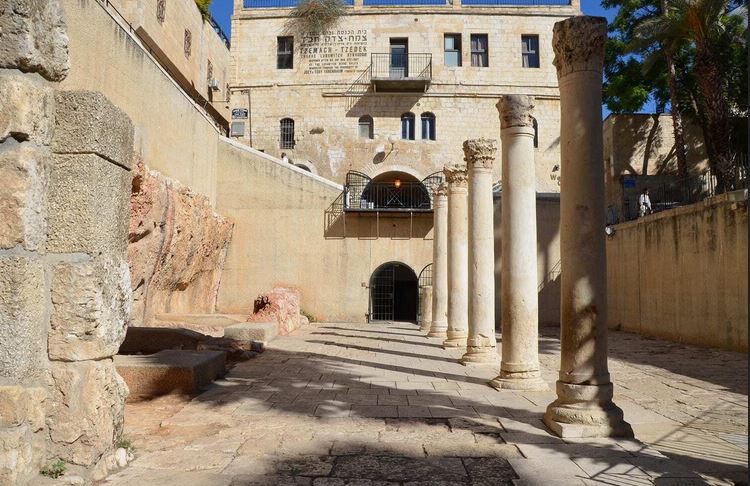Aelia Capitolina represents a pivotal chapter in the history of Jerusalem, marking a significant transformation during the Roman Empire. This Aelia Capitolina was the name given to the city of Jerusalem during the Roman Empire, specifically in the 2nd century CE. This renaming followed the suppression of the Bar Kokhba Revolt (132-135 CE), a major Jewish uprising against Roman rule. The new name was part of the Roman Emperor Hadrian’s broader strategy to assert control and diminish Jewish influence in the region.
Aelia: This part of the name honors Hadrian’s family name, Aelius. By incorporating his lineage into the city’s new name, Hadrian emphasized his role in its transformation and his personal connection to the city.
Capitolina: This term references the Capitoline Hill in Rome, a symbol of Roman authority and religious significance. Including Capitolina in the name highlighted the city’s new status as a Roman administrative and cultural center, aligning it with the grandeur and power of Rome itself.
The name change from Jerusalem to Aelia Capitolina was not merely a matter of rebranding; it was a deliberate effort to erase the city’s Jewish identity and reinforce its Roman character. This renaming reflected the broader Roman strategy of reasserting control and establishing a strong Roman presence in the city.

1. Historical Background
Origins of the Name
The name Aelia Capitolina was instituted by the Roman Emperor Hadrian following the suppression of the Bar Kokhba Revolt, a significant Jewish uprising against Roman rule that occurred between 132 and 135 CE. This revolt was a major challenge to Roman authority, and its suppression led to a series of punitive measures aimed at erasing the city’s Jewish identity and reinforcing Roman control.
“Aelia” was derived from Hadrian’s family name, Aelius. By incorporating his name into the city’s new designation, Hadrian underscored his personal connection to the city’s transformation and his role in its re-establishment as a Roman stronghold.
“Capitolina” references the Capitoline Hill in Rome, a symbol of Roman political and religious power. This part of the name was intended to signal the city’s new identity as a Roman administrative and cultural center, aligning it with the grandeur and authority of Rome itself.
Significance of the Name Change
The renaming of Jerusalem to Aelia Capitolina was part of a broader Roman strategy to diminish Jewish connections to the city and establish a distinct Roman presence. By renaming the city, the Romans aimed to erase Jerusalem’s historical and cultural ties to its Jewish past, thereby reinforcing Roman dominance and control.
The architectural and urban design of Aelia Capitolina reflected typical Roman planning principles. The city was restructured with forums, temples, and baths, embodying Roman architectural styles and urban norms. This transformation was more than a physical alteration; it represented a symbolic assertion of Roman power and an attempt to imprint Roman culture and governance on the city.

2. Religious and Cultural Impact
Impact on Jewish Communities
The renaming of Jerusalem to Aelia Capitolina had profound symbolic and cultural effects on Jewish communities. For Jews, the name change represented more than just a new designation for their city; it was a stark reminder of their loss of sovereignty and the imposition of foreign rule. The transformation of their ancient and sacred city into a Roman stronghold was a deliberate act of cultural suppression aimed at severing their historical and religious connections to Jerusalem.
The rebranding of the city symbolized the broader Roman strategy to diminish Jewish identity and control. By erasing the name Jerusalem, which held deep historical and religious significance for Jews, the Romans sought to undermine the collective memory and cultural continuity of the Jewish people. This renaming was a tangible sign of the subjugation of Jewish sovereignty and an attempt to assert Roman dominance over Jewish heritage and traditions.
Impact on Early Christian Communities
For early Christians, Aelia Capitolina played a complex role in their development. As the Roman city emerged, it became a focal point for the Christian community, which was establishing itself in a changing world. The transformation of Jerusalem into Aelia Capitolina marked a period of both adaptation and resistance for early Christians.
The city’s new Roman identity was reflected in early Christian texts and writings. While Aelia Capitolina represented a period of hardship and displacement for Christians, it also provided a context in which Christian identity and theology could evolve. The city’s transformation was a backdrop for the early Christian community’s efforts to define their place within the Roman world, navigating the tensions between their religious identity and the Roman authorities.
The name change and the new Roman infrastructure offered both challenges and opportunities for early Christians. On one hand, the Romanization of the city could be seen as a threat to Christian beliefs and practices. On the other hand, it also presented an opportunity for early Christians to engage with the broader Roman world and to establish their presence in a city that had been central to their faith’s origins.
3. Sources and Further Reading
Book Recommendations
- “The Roman Empire and Its Impact on the Jewish World” by M. Goodman
- Summary: This book provides an in-depth analysis of the Roman Empire’s influence on Jewish history, focusing on key events such as the Bar Kokhba Revolt and the subsequent transformation of Jerusalem into Aelia Capitolina. Goodman explores the political, cultural, and social impacts of Roman rule on the Jewish community, offering a comprehensive understanding of this significant period.
- Link to Book
- “Jerusalem: The Biography” by Simon Sebag Montefiore
- Summary: Montefiore’s work is a detailed historical narrative of Jerusalem, covering its complex history from ancient times to the modern era. The book includes a thorough examination of the period when Jerusalem was renamed Aelia Capitolina, providing context and insights into the city’s transformation under Roman rule.
- Link to Book
- “Hadrian and the Cities of the Roman Empire” by Marleen B. K. Reinders
- Summary: This book explores the impact of Emperor Hadrian’s policies on various cities within the Roman Empire, including Jerusalem. Reinders discusses Hadrian’s motivations behind the renaming of Jerusalem to Aelia Capitolina and the broader implications of his urban planning and political strategies.
- Link to Book
In summary, the renaming of Jerusalem to Aelia Capitolina was a significant event with far-reaching implications for both Jewish and Christian communities. The transformation of the city under Roman rule not only altered its physical appearance but also symbolized a broader strategy of cultural suppression and dominance. For Jews, the renaming was a poignant reminder of their loss of sovereignty, while for early Christians, it marked a period of adaptation and growth in a new Roman context.
The historical and cultural importance of Aelia Capitolina lies in its reflection of Roman imperial policies and their impact on local identities. By exploring the suggested sources, readers can gain a deeper understanding of the complexities surrounding this pivotal moment in Jerusalem’s history.
Frequently Asked Questions (FAQ)
1. What was Aelia Capitolina?
Aelia Capitolina was the name given to Jerusalem during the 2nd century CE, following the Bar Kokhba Revolt. It was established by the Roman Emperor Hadrian as part of a strategy to reshape the city and assert Roman dominance after suppressing the Jewish uprising.
2. Why was Jerusalem renamed to Aelia Capitolina?
The renaming of Jerusalem to Aelia Capitolina was a result of Hadrian’s efforts to diminish Jewish ties to the city and establish a stronger Roman presence. The name change symbolized the transition from a Jewish to a Roman identity, with “Aelia” honoring Hadrian’s family name and “Capitolina” referencing the Capitoline Hill in Rome, representing Roman power.
3. What was the Bar Kokhba Revolt?
The Bar Kokhba Revolt (132-135 CE) was a major Jewish uprising against Roman rule led by Simon Bar Kokhba. It was an attempt to regain Jewish independence and was ultimately suppressed by the Romans, leading to significant changes in Jerusalem, including its renaming to Aelia Capitolina.
4. How did the renaming of Jerusalem impact Jewish communities?
For Jews, the renaming to Aelia Capitolina represented a profound cultural and symbolic loss. It was seen as an attempt by the Romans to erase Jewish identity and heritage from the city. The transformation was a stark reminder of the suppression of Jewish sovereignty and traditions.
5. What effect did Aelia Capitolina have on early Christian communities?
Early Christians faced a complex situation under Roman rule. Aelia Capitolina became a significant location for the early Christian community, which had to navigate the challenges of Roman control while establishing their faith. The city’s Romanization presented both obstacles and opportunities for early Christians.
6. What architectural changes were made to Aelia Capitolina?
Under Roman rule, Aelia Capitolina was redesigned with Roman architectural elements, including forums, temples, and baths. These changes reflected Roman urban planning principles and aimed to establish a distinctly Roman character for the city.
7. Where can I find more information about Aelia Capitolina and its historical context?
For more detailed information, consider reading:
- “The Roman Empire and Its Impact on the Jewish World” by M. Goodman
- “Jerusalem: The Biography” by Simon Sebag Montefiore
- “Hadrian and the Cities of the Roman Empire” by Marleen B. K. Reinders




